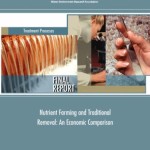
The purpose of this study was to assess the economic feasibility of using large-scale, restored wetlands to assist publicly owned treatment works (POTWs) in meeting the U.S. Environmental Protection Agency’s (USEPA) recommended criteria for nutrients, specifically, total nitrogen (2.18 mg/l) and total phosphorous (0.076 mg/l). The assessment compares the cost of nutrient control by advanced wastewater treatment technology to that of wetland treatment technology. The comparison was based on several economic factors: annual operating costs, average costs, marginal costs, and present value. To explore the economic relationship between wastewater and treatment wetlands and to quantify the magnitude of wetland area needed, a case study was developed using the seven water reclamation plants (WRPs) owned and operated by the Metropolitan Water Reclamation District of Greater Chicago (MWRDGC) and proposed treatment wetlands located adjacent to the Illinois River in the upper Illinois River watershed. Cost functions for both technologies were developed. Using these functions, the economic characteristics of the two technologies were compared assuming, first, that the USEPA’s proposed nutrient criteria would be enacted as the enforceable water quality standard by the state regulator, and, second, that a less stringent standard would be established (3.0 mg/l TN and 1.0 mg/l TP). However, the USEPA’s phosphorus criterion was modified due to the technical difficulty in achieving an effluent concentration of 0.076 mg/l TP. The more stringent phosphorous criterion was set at 0.5 mg/l TP for this comparison study. To meet the future nutrient criteria, the physical facilities of the seven MWRDGC treatment plants must be upgraded to incorporate biological nutrient removal (BNR) technology. A detailed capital cost analysis for the addition of BNR treatment, specifically the 5-stage Bardenpho (with methanol addition), was performed by the MWRDGC for one of its larger WRPs, Calumet. The capital costs for the other plants were estimated using Calumet’s cost formulas and prorated by the design flows. The operating and maintenance (O&M) costs were estimated to add approximately 50% to those for the conventional treatment currently being employed by MWRDGC. The capital costs for upgrading the seven WRPs with the Bardenpho system has been estimated at $1.6 billion with the total present value cost at $2.5 billion.
Read More →


